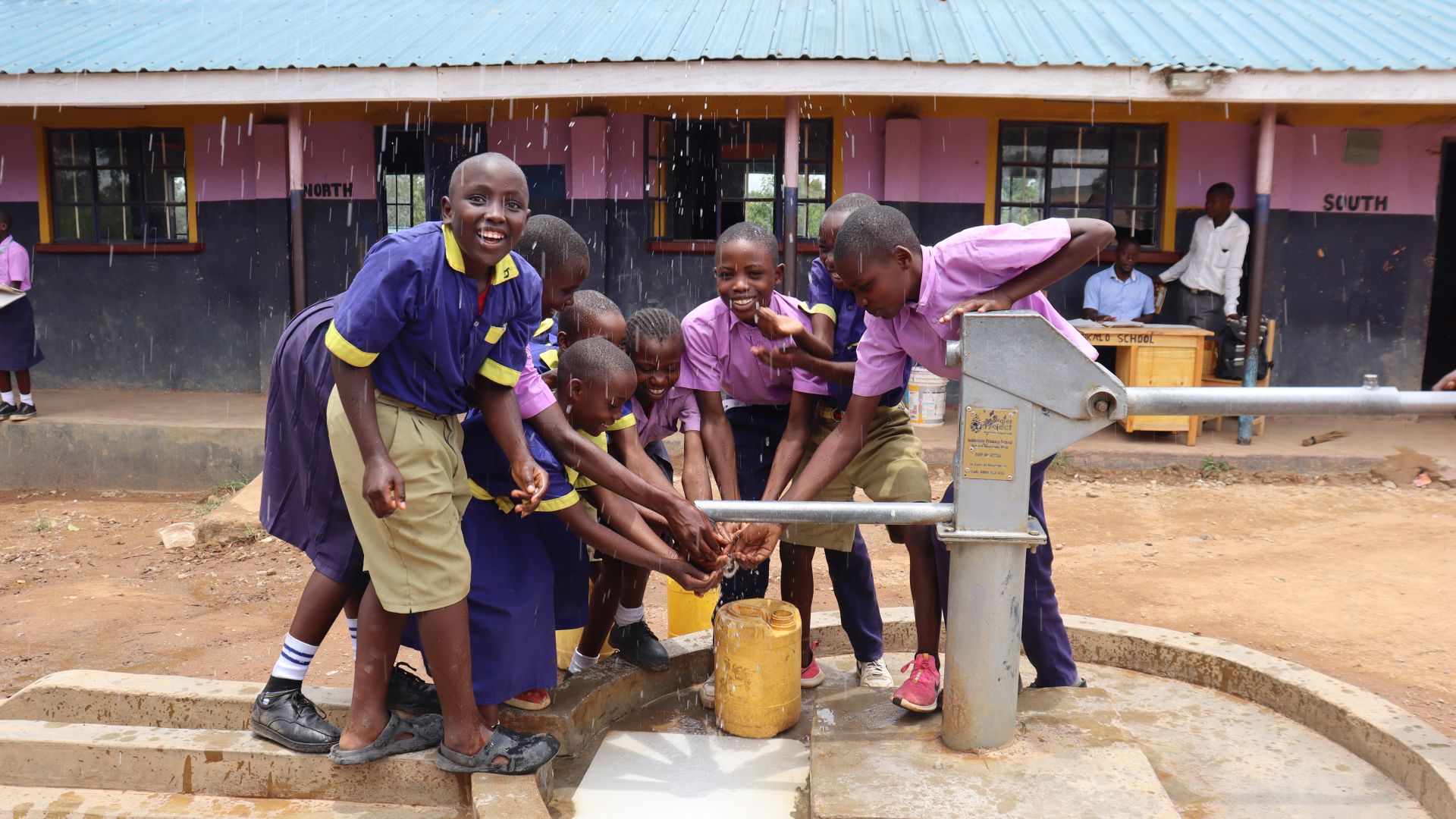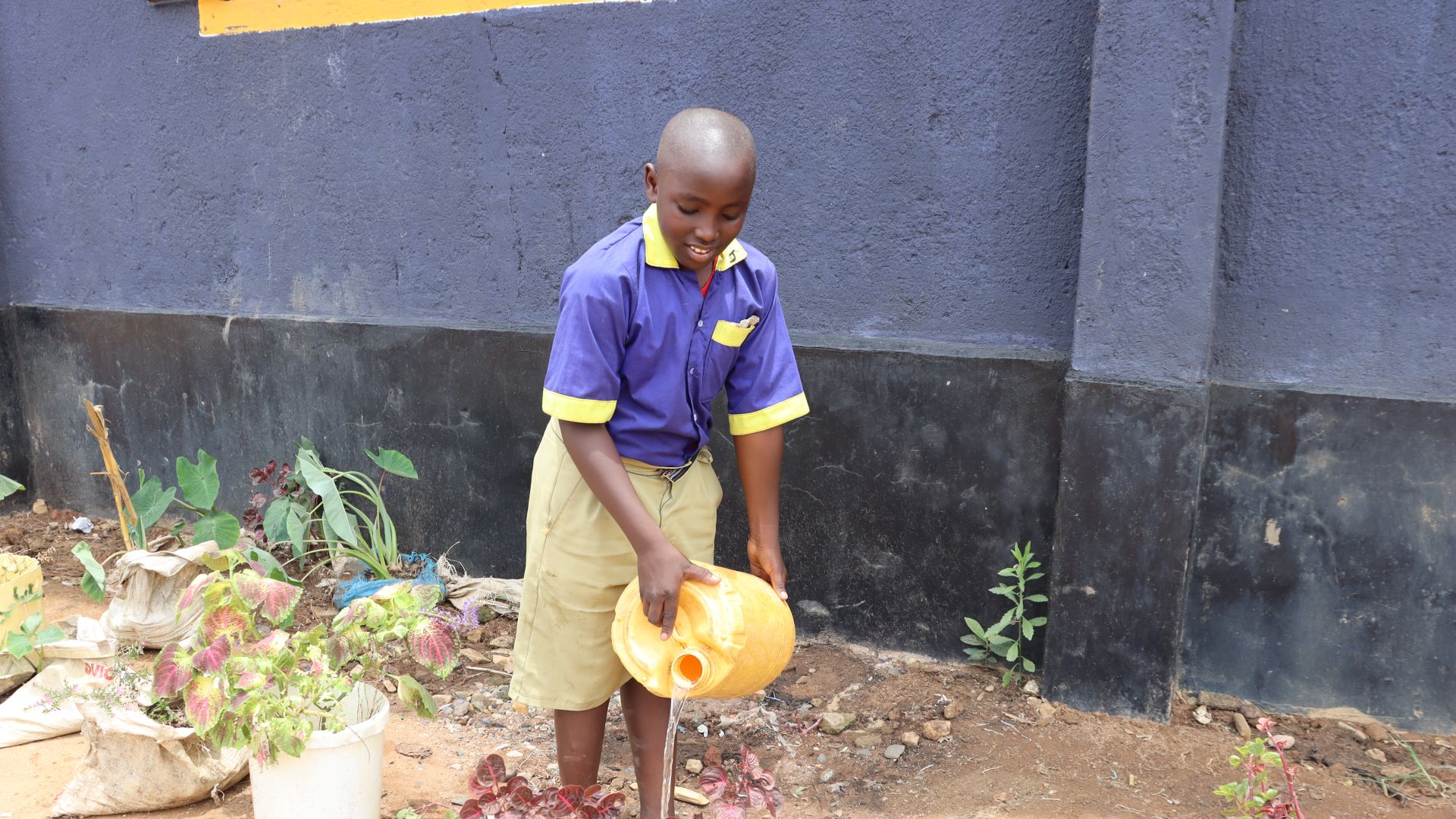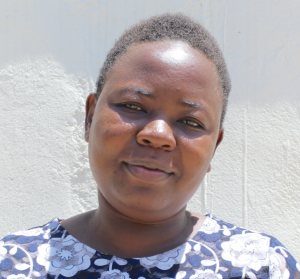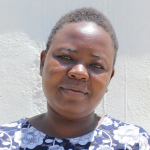March, 2024: Imbiakhalo Primary School Well Complete!
We are excited to share that Imbiakhalo Primary School in Kenya now has access to a new safe water source thanks to the completion of their borehole well! Students and staff are already using the well's flowing water, which will provide them with a reliable water source for all of their daily needs.
We also installed new latrines and handwashing stations and trained students and staff on improved sanitation and hygiene practices. Together, these components will unlock the opportunity for these students to live better, healthier lives.

"Because of water rationing, we were forced to carry drinking water from home. The water brought from home was not sufficient, so we could stay longer without drinking water, hence being dehydrated and falling sick. But with reliable and safe water at the school compound, I will be in good health and energetic. I will make good use of the time that I used to waste to improve my grades," said 11-year-old Jacob.

Jacob.
"Unfortunately, we do not stay next to the school compound otherwise, we would be fetching water from this water point. However, our parents will have [an] easy and useful time knowing that we students at school are safe and healthy. This is because the rate of students falling sick after having unsafe water will reduce, and parents will be able to save money that could be used to cater for our medications whenever we fall sick. The money will be used for other development projects at home. Our teachers will also have time to complete the syllabus in time, which will help improve our school mean score," Jacob concluded.
Teachers were just as excited as the students about the new well on campus.
Thirty-five-year-old teacher Sayana Lutomia shared, "Having water within our school compound has made everything easy for us. We shall have enough time to finish our syllabus and embark on revision, which will improve our academic performance. Secondly, we were challenged by [the] Kakamega County Commissioner to start a tree nursery, not just trees, but indigenous trees. We will use this water to irrigate the tree seedlings, and we will sell them to the community at a lower price to encourage them to embrace water-friendly trees for environmental conservation as we were taught."

Sayana Lutomia.
How We Got the Water Flowing
Parents, staff, and students all contributed to this well's success. After determining the best site for the well through a hydrogeological survey, we obtained approval and a license from the government to begin drilling.
To prepare, the school collected fine sand and water for cement-making. When everything was ready, our drill team and staff arrived at the school to begin work.
"The school administration did a wonderful job. They ensured all the materials needed were available before the project began. The school management had a board meeting with board members and agreed to distribute the materials required among themselves for faster preparation. So, every board member had to pick an item from the required list and act on it promptly. This alone shows good cooperation between the school and its board of management, where everything went smoothly as planned, and that made our work easy and enjoyable," shared Field Officer Stella Inganji.

Drilling.
Drilling commenced with excitement in the air. The team drove down a temporary casing to keep the walls from collapsing as the rig progressed. We continued drilling to reach a final depth of 80 meters with a final static water level of 6 meters.
The drilling process can take up to three consecutive days to complete due to this region's hard bedrock, so the drill team set up a camp where they could rest and refuel. The school's kitchen staff and parents helped provide meals for the team, while the school provided a safe place for the artisans' accommodations and materials.
Once we reached the required depth, the team replaced the temporary casing with a permanent version then bailed out the dirty water at the bottom of the well. The workers installed pipes, flushed them, tested the well's yield, and chlorinated the water.

Installing the well pad.
After water treatment, we constructed a cement well pad to seal off the well from any ground-level contaminants. Tiles are installed beneath the spout to protect the cement from the erosive force of the water.
We also included a short drainage channel to carry spilled water away from the pump and prevent standing water. A soak pit absorbs runoff at the end of the drainage channel, further eliminating any stagnant water.
When the well pad was dry, we installed a new stainless steel AfriDev handpump and sampled the water for a quality test. The results showed this water was safe for drinking!
We officially handed over the new borehole to the school's students and teachers.

Installing the pump.
Students and staff celebrated the presence of clean water on campus. The event was an excellent chance to acknowledge the school administration and students as the primary parties entrusted with the tools we have given and remind them of our continued support as they develop. Happiness, thanksgiving, and appreciation were the order of the day, flowing in all directions.
Several different dignitaries, including the Kakamega County Commissioner, the Subcounty Director of Education for Kakamega North, the Water Resources Management Authority Regional manager, the division Commander of Police, along with area spiritual leaders, parents, teachers, pupils, and the team. Pupils welcomed the guests with songs and dancing. The guests concluded the ceremony by planting trees on the school compound to remember the importance of conservation of the environment.

The completed well.
"Headteacher Mr. Samuel was very excited when he saw water flowing from the pump. The students clapped with joy while dancing and singing traditional songs. With water at the school compound, the headteacher promised that the school would not be the same again in terms of performance, and sanitation and hygiene-related challenges [would] greatly reduce," shared Stella.
VIP Latrines

The completed boy's latrine.
This project funded the installation of six new ventilated improved pit (VIP) latrines. These new latrines have cement floors designed to be easy to use and clean, locking doors for safety and privacy, and vents to keep air flowing up and out through the roof. With a well right on school property, there should be enough water to keep them clean.
Handwashing Stations

Handwashing station.
We set up two handwashing stations outside the latrines and handed them over to the newly formed student health club. Health club members will teach other students how to wash their hands at the stations properly, fill the stations with water, and ensure that there is always a cleaning agent available.
New Knowledge
We scheduled hygiene and sanitation training with the school's staff, who ensured that the training date would be convenient for pupils and teachers. When the training day arrived, facilitators Stella Inganji and Betty Muhongo deployed to the site to lead the event. 24 students and teachers attended the training, which we held at the school.

We focused on personal, menstrual, oral, and environmental hygiene; proper water handling; soap-making and the ten steps of handwashing; the importance of primary health care, the prevention of teen pregnancy and COVID-19; child rights; the operation and maintenance of the pump, well, latrines, and handwashing stations; and leadership and governance. During the latter, the students elected their peers to lead their newly formed student health club.
The student health club members will encourage good health and hygiene practices amongst their peers, teachers, and the larger community. By the end of the training, each pupil understood their role in sustaining clean water and good health within their school community.

Learning to make soap.
"Water handling turned out to be our memorable topic during the training. Most students thought that borehole water is always clean regardless of how it is handled. So, we had to shed more light on how the water can be contaminated if wrongly handled. We asked them to ensure the environment around the water point is always clean, and the containers used to draw water should be clean as well," shared Stella.
The girls attending the training were not comfortable learning and sharing about menstrual hygiene publically, so Ms. Sayana, the sanitary teacher, privately covered the topic with them.

Learning proper handwashing techniques.
"During [the] handwashing demonstration, we asked two pupils to demonstrate how they wash their hands, and one of them, after following the ten steps keenly, ended up drying [his] hands with a very dirty handkerchief. That made participants laugh, and [he was] asked to redo the handwashing steps," Stella said.
"Both teachers and pupils were very happy to learn how to make soap. As a school, we have been purchasing it at 2500 Ksh ($17 USD). [We] realized we have been spending a lot. We wish to start as a business and do it as a CTC (Child to Child) club," said Sayana.
"I have learned that it's not a must that we buy everything for one to maintain good hygiene practices. We can improvise or use locally available materials and still meet high hygiene standards. A good example is using salt instead of toothpaste to brush teeth and using ash for disinfecting our latrines to avoid bad odors and flies, among others. Most of the time, we assume we know everything until we are challenged, and then we will realize that learning is a process. Thanks for the opportunity. We will try to pass the information on to other students and stop assuming everything," concluded Sayana.
Conclusion
This project required a substantial collaboration between our staff, our in-country teams, and the community members. When an issue arises concerning the well, the students and teachers are equipped with the necessary skills to rectify the problem and ensure the water point works appropriately. However, if the issue is beyond their capabilities, they can contact their local field officers to assist them.
Also, we will continue to offer them unmatchable support as a part of our monitoring and maintenance program. We walk with each community, problem-solving together when they face challenges with functionality, seasonality, or water quality. Together, all these components help us strive for enduring access to reliable, clean, and safe water for this community.
With your contribution, one more piece has been added to a large puzzle of water projects. In Kenya, Uganda, and Sierra Leone, we're working toward complete coverage. That means reliable, maintained water sources within a 30-minute round trip for each community, household, school, and health center. With this in mind, search through our upcoming projects to see which community you can help next!
Thank you for making all of this possible!









 Borehole Well and Hand Pump
Borehole Well and Hand Pump
 Rehabilitation Project
Rehabilitation Project


































